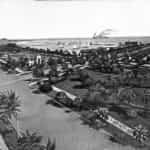
This view, from the end of the Railroad Pier, shows the condition of the downtown waterfront in the early 1900s, when it was used as much for industrial purposes as it was for recreation. Photo courtesy of the State Archives of Florida.
In 1895 railroad baron Henry Plant – no fan of St. Petersburg, which he considered a threat to his holdings in Tampa –began charging independent boat operators a minimum of $25 to use the railroad pier, severely impacting local fishermen. In response, local boat builder D.F.S. Brantley built a pier three blocks away at Second Avenue North. The Brantley Pier stretched 1500 feet into the bay and could service boats drafting seven feet of water, but its distance from the rail line eliminated it as a serious threat to Plant’s Railroad Pier. The Brantley Pier did, however, become popular for its 34-room bathing pavilion – a sign of things to come on the waterfont.
With the Railroad Pier and Brantley Pier serving two functions – that of industry and leisure – the stage was set for a showdown. Should the city’s waterfront be dedicated to smelly fish-houses and the belching smokestacks of power plants? Or beautified for the enjoyment of residents and visitors alike? Tensions quickly arose between community leaders over the dueling interests of the fishing industry and tourism. Proponents of the “city beautiful” movement, led by St. Petersburg Times editor William Straub, advocated for the creation of livable cities through the inclusion of public parks and designed landscapes into the urban environment.

By 1910, William Straub had convinced the City to purchase the downtown waterfront as dedicated public parkland. Today, the city boasts more than 7 miles of green space along the waterfront. Photo courtesy of the State Archives of Florida.
Straub cajoled his readers to envision a more beautiful St. Pete, with better roads, sidewalks, and schools. He argued that the current waterfront offered no place for tourists to stroll and enjoy the views across Tampa Bay. While supporting commercial efforts Straub proposed they be moved to a more suitable location where they wouldn’t compromise the beautiful waterfront that attracted tourists.
Straub began to use the pulpit of his newspaper to advocate for public ownership of the waterfront, urging the movement of commercial activity down to the recently drained Bayboro Harbor. But this was a progressive idea for a small southern city, and citizens were reluctant to pay for it. Fearing the loss of his beloved waterfront, Straub convinced other wealthy community leaders to buy up much of the waterfront and hold it in trust for the city.
Altruistic as he was, Straub was not above a strategic ruse. He cleverly formed the new waterfront property owners into the “St. Petersburg Waterfront Company”, which he described in the Times as northern entrepreneurs interested in developing the waterfront. Straub believed the threat of massive commercial development would stir public indignation and force the council to purchase the waterfront property. It worked. When rumors went out that “yankees” intended to build an industrial center on the waterfront, residents besieged the city council. After much political wrangling the Waterfront Park was officially dedicated in December of 1910.
A tireless advocate for the city, Straub was also responsible for the movement that formed Pinellas County out of Hillsborough County. A Hillsborough county official noted that “if we had not fought him hard and constantly, he would have stolen Tampa Bay, the Gulf of Mexico, and the flurry of clouds from out of our skies.”



